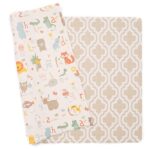5 days a week our life is:
getting 4 little girls dressed
fed
teeth brushed
hair brushed
waterbottles
snacks
lunches
folders
library books
backpacks packed
and so many more little inbetweener steps I can’t even list!
And would you believe our mornings run quite smoothly?! It’s not because we were blessed with easy peasy, compliant children who just adore listening the first time a direction is given! It’s because I made a visual schedule for them and they know exactly what to do. What their job is, what my job is, what their dad’s job is.
This is where a visual to do list/visual schedule comes into play!
What on Earth is a Visual Schedule?
Imagine having a magical guide that shows your little one exactly what’s coming up next in their day, step-by-step. That’s what a visual schedule does! It’s a tool that uses pictures, symbols, and simple text to outline daily activities and routines. It provides a visual representation of what a child is expected to do throughout the day, breaking down tasks into clear, manageable steps. This approach helps children understand and anticipate what’s coming next, offering them a sense of predictability and control.
Why You’ll Love Visual Schedules
1. Transforms “What’s Next?” into “Got It!”
Ever tried explaining to your child for the millionth time what comes next in their routine? Yeah, it’s like trying to teach a cat to fetch. Visual schedules cut out the guesswork by laying it all out visually. Kids get to see exactly what’s next, making those “what do I do now?” moments a thing of the past.
2. Reduces Meltdowns and Drama
Predictability is a big deal, especially for kids with special needs like Down syndrome. When they know what’s coming up next, it isn’t them having to listen to *you* it’s them just following the paper. Instead of facing off in a daily battle of wills, you’ll find yourself navigating smoother transitions with less fuss.
3. Keeps Them Focused and Engaged
If you’ve ever watched your child get sidetracked by a speck of dust, you know how tricky it can be to keep them on track. Visual schedules help by breaking down tasks into bite-sized, visual chunks. It’s like having a to-do list that’s been turned into a fun game, helping your child stay engaged and focused.
4. Teaches Life Skills While You’re At It
Who knew that a simple schedule could double as a life skills trainer? As your child follows the visual schedule, they’re not just completing tasks—they’re learning about organization, time management, and how to follow a sequence. It’s like sneaking in a little extra learning without them even realizing it! It is also building habits so they don’t have to make the choice to brush their teeth, that is just the habit so it can be done without thinking about it.
How to Get Started: Your Visual Schedule Adventure
1. Spot the Trouble Zone
First things first, take a good look at your child’s day and figure out which part of their routine is causing the most stress. Is it the morning chaos of getting dressed, or the bedtime struggles of winding down? Pick one area where a visual schedule could work its magic.
2. Create Your Visual Schedule
Now, time to get crafty! Start by designing a simple visual schedule: (or buy my simple am/pm one here)
- Pick Your Format: Choose whether you want to use photos, drawings, or a mix. You can even add a dash of humor with silly illustrations!
- Break It Down: Divide the tricky routine into easy steps. For example, if the morning routine is the culprit, include visuals for brushing teeth, putting on socks, and so on.
- Display It: Put the schedule somewhere your child can see it—like right by their bedroom door or next to the breakfast table. Make sure it’s at their eye level so they can easily follow along.
3. Introduce and Celebrate
When you introduce the visual schedule, make it a big, exciting deal. Sometimes just being excited as you practice the schedule is enough motivation, sometimes you need a little extrinsic motivation to help. Consistency is key, so stick with it and watch as your child starts to embrace their new routine.
4. Tweak as Needed
As with any new tool, you might need to make a few adjustments along the way. If something isn’t quite working or if your child has new needs, don’t be afraid to tweak the schedule. It’s all about finding what works best for your family.
Visual schedules are like having a trusty sidekick in your parenting toolkit. They’re here to make daily routines easier, reduce stress, and even sneak in some life lessons. By breaking down routines into visual steps, you’re helping your child navigate their day with a bit more confidence and a lot less chaos.
So, grab your markers, get creative, and start making your visual schedule today. Your future self—and your child—will thank you!





